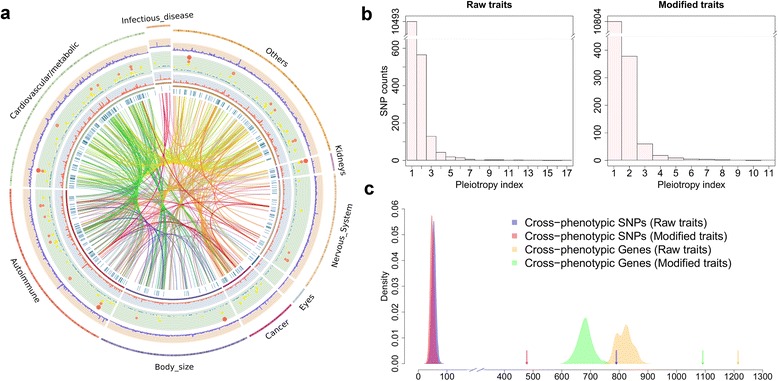Fig. 1.

Cross-phenotype and pleiotropic SNPs in the NHGRI GWAS Catalog. a Circle plot of all NHGRI GWAS Catalog SNPs grouped into nine broad categories of traits. Moving from the outermost circle inward, the circles represent a linear representation of the karyotype of the human genome with different background colors for each trait category, density of GWAS SNPs per 5 Mb along the genome, scatter plot of “pleiotropic index” (the number of traits associated with each SNP), and density plot of cross-phenotype SNPs in 5-Mb windows along the genome. In the scatter plot of “pleiotropic index” larger circles and colors from blue to yellow to orange to red represent a SNP being associated with more traits. The blue vertical lines represent genomic positions of cross-phenotype SNPs within each pre-defined group and inner rainbow lines represent cross-phenotype SNPs connecting different groups, with the color indicative of the trait categories being connected. b Histogram of NHGRI GWAS Catalog SNPs based on “pleiotropic index”. Raw traits are directly from the NHGRI GWAS Catalog while modified traits have been manually curated to merge closely related phenotypes and to remove phenotype categories that had combined multiple diseases. A total of 789 SNPs 7.0 %) were associated with more than one trait for raw traits and 478 SNPs (4.2 %) were associated with more than one trait for modified traits. c Enrichment of cross-phenotype SNPs in the NHGRI GWAS Catalog. Distribution of cross-phenotype SNPs expected by chance (histograms) are plotted along with the observed number of cross-phenotype SNPs in the NHGRI GWAS Catalog (arrows). We used a permutation-based method to test whether there is significant enrichment of cross-phenotype SNPs/genes in the GWAS Catalog. We randomly resampled SNPs from a pool of unique SNPs and assigned to each disease and constructed the null distribution by repeating this process 10,000 times. Significant differences (p < 0.0001) were detected for both SNPs and genes
